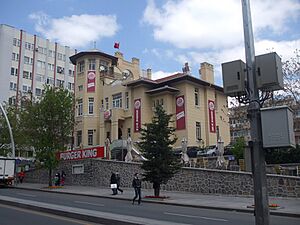Americanization facts for kids

Americanization is about how the culture and economy of the United States influence other countries. This includes things like American movies and TV shows, food, music, technology, and even ways of doing business or politics. Some people think Americanization means progress and new ideas.
American movies have been very popular around the world since the early 1900s. They show people how Americans live, dress, and act. Many of the biggest movies ever made were created or funded by U.S. companies. Even movies like Harry Potter or The Lord of the Rings, which are very British, are sometimes called "American productions" because U.S. companies helped pay for them. This shows how American companies can influence things from other cultures.
Big American companies that operate worldwide are also a part of Americanization. For example, the Coca-Cola Company was once the world's top company. This led to the phrase "Coca-Cola diplomacy," meaning the friendly influence the U.S. has on other countries. Many American fast food chains like McDonald's, Subway, Starbucks, Burger King, Pizza Hut, KFC, and Domino's Pizza have restaurants all over the world. Also, many of the world's biggest technology companies, like Apple Inc., Google, Microsoft, Amazon, Facebook, and IBM, are based in the U.S.
During the Cold War (a time of tension between the U.S. and the Soviet Union), Americanization was a way for the U.S. to spread its influence peacefully, instead of using military force. This was especially true in education. After the Soviet Union broke apart in 1991, the U.S. became the world's only superpower, and American influence grew even more. The rise of high-speed internet in the mid-2000s also helped spread American culture and technology globally.
Some people have concerns about Americanization. In the 1960s, some Europeans worried about too many U.S. businesses investing in their countries. Today, some people worry about how much American internet technology, like Google and Facebook, affects their lives.
Contents
What is Americanization?
The term "Americanization" can be a bit tricky, but most people agree on what it means. It's about how American ideas, ways of doing things, and products spread to other countries.
How American Culture Spreads
American culture spreads in many ways:
- Movies and TV: Hollywood films and TV shows are watched by millions worldwide. They often show American lifestyles, fashion, and values.
- Music: American pop, rock, and hip-hop music are popular globally.
- Food: Fast food chains like McDonald's and Starbucks are found in almost every country.
- Technology: Many of the most used computer programs, phones, and social media apps come from U.S. companies.
- Business Ideas: American ways of running businesses, like marketing and efficiency, are often copied elsewhere.
American Businesses and Brands Around the World

Many of the world's largest companies started and are based in the United States. These include Alphabet (which owns Google), Amazon, Apple, Coca-Cola, Disney, McDonald's, Nike, Meta (which owns Facebook), Microsoft, and Walmart.
Coca-Cola is often seen as a symbol of American influence. The American fast food industry was the first and largest in the world. Companies like McDonald's, Burger King, Pizza Hut, Kentucky Fried Chicken, and Domino's Pizza have thousands of locations globally.
Many of the biggest computer companies are also U.S.-based, such as Microsoft, Apple, Intel, HP Inc., Dell, and IBM. A lot of the software used worldwide is made by these American companies. Experts say the U.S. has a very strong position in the software industry globally.
Even as far back as the early 1900s, some people saw "Americanization" as a sign of progress and new ideas. In Germany during the 1920s, American ideas about efficiency and making things faster were very popular. This was called "rationalization." It meant using science to improve how things were made and how businesses were run, promising more wealth and a modern way of life.
During the Cold War, Americanization was a way to counter the spread of Soviet influence around the world. Education, especially universities, was a main focus for Americanization. Even though there was some resistance, it was more successful than the Soviet Union's efforts to spread its own ideas.
How American Influence is Seen

From 1950 to 1965, American companies invested a lot more money in Europe. This made many people talk about Americanization. Even though American investments were a small part of Europe's total economy, they were very noticeable. People sometimes disliked American advertising, business methods, and the use of English by American companies. However, by the 1970s, European companies started investing more in the U.S., and people talked less about the U.S. "buying up" Europe.
Recent Trends in Americanization
Americanization has grown even more since the collapse of the Soviet Union in 1991. Before that, communist newspapers often criticized the U.S. Today, some countries, like Russia and China, still show similar tendencies. For example, in 2013, Russian President Vladimir Putin wrote an article saying it was dangerous for any country to think of itself as "exceptional."
A new concern about Americanization is the widespread use of American internet technology. Since 2008, with the rise of high-speed internet and smartphones, many new apps and devices come from places like Silicon Valley in the U.S. In Europe, there are growing worries about how much power American internet companies like Google, Facebook, Twitter, iPhone, and Uber have. European governments are concerned about privacy, fair competition, and taxes related to these big American companies. They worry that these companies might not be paying enough taxes or might be handling personal information in ways that break European privacy laws.
History of the Term
In 1902, a British journalist named William Stead wrote a book called The Americanization of the World. In it, he talked about how American ideas were becoming more and more popular.
Historians study how the U.S. has influenced Europe, especially during the Cold War. They look at how American culture and economy spread, and how this was sometimes a two-way exchange of ideas.
See also
- American culture
- American Dream
- American imperialism
- Americanization (immigration)
- Anti-American sentiment
- Cocacolonization
- Cultural imperialism
- McDonaldization
- Pax Americana
- Soft Power
- Westernization
 In Spanish: Americanización para niños
In Spanish: Americanización para niños



